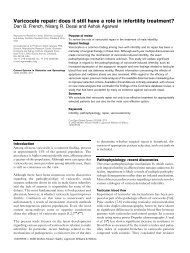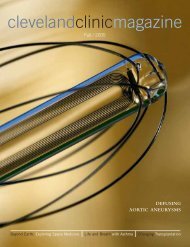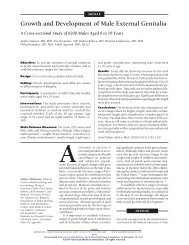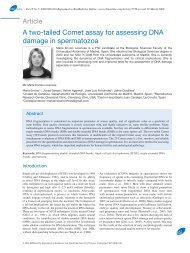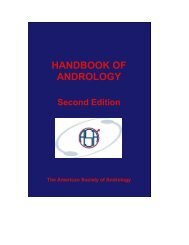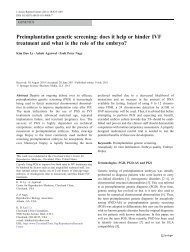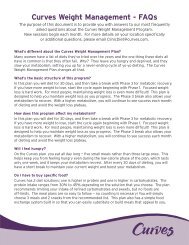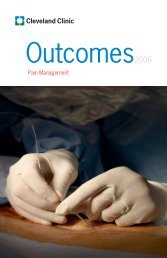Artificial Insemination
Artificial Insemination
Artificial Insemination
Create successful ePaper yourself
Turn your PDF publications into a flip-book with our unique Google optimized e-Paper software.
Ch36-A03309.qxd 1/23/07 5:16 PM Page 544<br />
Section 6<br />
Infertility and Recurrent Pregnancy Loss<br />
A<br />
curved tip is directed in a new course and re-advanced. This<br />
procedure is continued until the catheter can be advanced<br />
without resistance approximately 5 to 6 cm into the uterine<br />
cavity. Rarely, a cervical tenaculum is required to apply downward<br />
traction on the cervix to “straighten” an exceptionally<br />
tortuous canal.<br />
A second method for navigation of the endocervical canal for<br />
IUI is by using a semirigid yet flexible catheter that has no<br />
memory. 42 Pressure is used to force the catheter to follow the<br />
course of the canal. This technique often requires the use of a<br />
cervical tenaculum to apply countertraction. Because the diameter<br />
of some of these types of catheters is usually larger in caliber<br />
(greater than 3 mm), dilatation is sometimes required in the<br />
presence of cervical stenosis.<br />
544<br />
B<br />
Figure 36-1 Intrauterine insemination catheters: A, Tefcat catheter<br />
attached to a syringe (Cook Group, Bloomington, Ind.); B, CryoBioSystem<br />
catheter (CryoBioSystem, Paris).<br />
IUI TECHNIQUE<br />
IUI is performed using one of several commercially available<br />
intrauterine insemination catheters connected to a 2-mL syringe<br />
(Fig. 36-1). With the fully awake patient in a dorsal lithotomy<br />
position, the cervix is visualized with a bivalve vaginal speculum.<br />
After excess vaginal secretions are wiped from the external<br />
cervical os, the tip of a thin flexible catheter is passed into the<br />
uterine cavity, and the sperm sample, suspended in less than 1 mL<br />
of wash media, is gently expelled high in the uterine cavity.<br />
Increased resistance during injection suggests that the catheter<br />
is kinked or the tip might be inadvertently lodged in the endometrium<br />
or tubal ostia. In this situation, the catheter should be<br />
withdrawn 1 cm, and injection reattempted. After IUI, the<br />
catheter is slowly removed and the patient allowed to remain<br />
supine for 10 minutes after insemination in case she experiences<br />
a vasovagal reaction.<br />
Occasionally, there is difficulty navigating the often tortuous<br />
course of the endocervical canal with the tip of the insemination<br />
catheter. There are two common approaches to this blind<br />
procedure. Most commonly, a thin catheter (external diameter<br />
less than 2 mm) with a “memory” is used so that the tip can be<br />
bent 20 to 90 degrees , thus allowing angular navigation in<br />
any direction by carefully twisting the catheter as it is gently<br />
advanced. Resistance in any direction requires that the catheter<br />
tip be withdrawn a matter of millimeters, twisted such that the<br />
FACTORS THAT PREDICT PREGNANCY RATES<br />
The highest pregnancy rates with IUI are seen within three to<br />
four cycles. 43 The average live birth rate per cycle is approximately<br />
10%. 18 Cumulative pregnancy rates depend on the characteristics<br />
of the couples being treated. In most reports, the<br />
cumulative pregnancy rate reaches plateau after three to six cycles.<br />
It is difficult to predict with certainty whether pregnancy will<br />
occur. Several models have been proposed but have not been<br />
validated. 44,45<br />
Male Factors That Predict IUI Success<br />
Men who have normal seminal characteristics have a higher<br />
chance of initiating a successful pregnancy as a result of IUI than<br />
those with abnormal results on semen analysis. This association<br />
is probably related to two associated factors. First, an abnormal<br />
semen analysis is often associated with an impaired fertilization<br />
capacity. Secondly, pregnancy rates positively correlate with the<br />
total number of motile sperm recovered for IUI, and this number<br />
is often lower in men with abnormal results on semen analysis.<br />
Semen Analysis Characteristics<br />
Semen characteristics clearly affect IUI outcome. 46 IUI is a<br />
successful treatment for mild male factor infertility, defined as a<br />
total motile sperm count of more than 5 million and Kruger<br />
morphology of more than 5%. 47 In a study in patients with mild<br />
male factor infertility, a live birth rate of 19% per cycle was<br />
reported. 47<br />
When prepreparation semen analyses characteristics are<br />
evaluated, the chances of pregnancy after IUI correlate best with<br />
morphology. A meta-analysis of six studies using strict morphology<br />
criteria (Kruger) showed that when the prewashed semen<br />
specimen had more than 4% normal sperm morphology, the<br />
chances of pregnancy after IUI were significantly increased. 48<br />
If the WHO standards were used to evaluate sperm morphology,<br />
the presence of more than 30% abnormal sperm in the ejaculate<br />
adversely influenced the pregnancy rate. 49<br />
Total Motile Sperm Count<br />
The sperm variable most clearly associated with pregnancy rates<br />
after IUI is the total motile sperm count after sperm wash or<br />
swim-up. In a retrospective study of 9963 IUI cycles, the likelihood<br />
of subsequent pregnancy was maximized when the IUI<br />
sample contained more than 4 million motile sperm numbers



